Satellite is very simple
We quickly get used to progress. Things that several years ago seemed fantastic to us are not noticed today and are perceived as always existing. Enough to delve into old things, when suddenly there is a monochrome mobile phone, floppy disk, tape cassette or even a reel. Not so long ago it was. Not so long ago, the Internet was "on coupons" under the creak of a modem. And someone remembers 5.25 "hard drives or even cassette tapes with computer games. And there will definitely be someone who says that in his time there were 8" floppy disks and reels for an EU computer. And at that moment nothing was more modern than that.
These weeks you can watch traditional events dedicated to the launch of the first Satellite - the beginning of the Space Age. The strength of the case satellite, which should be the first, became the third. And the first to fly a completely different device.
This text is about how easy it is to hear satellites in near-earth orbits and how it was at the beginning of the space age. Paraphrasing a once famous book by E. Iceberg: “Satellite is very easy!”
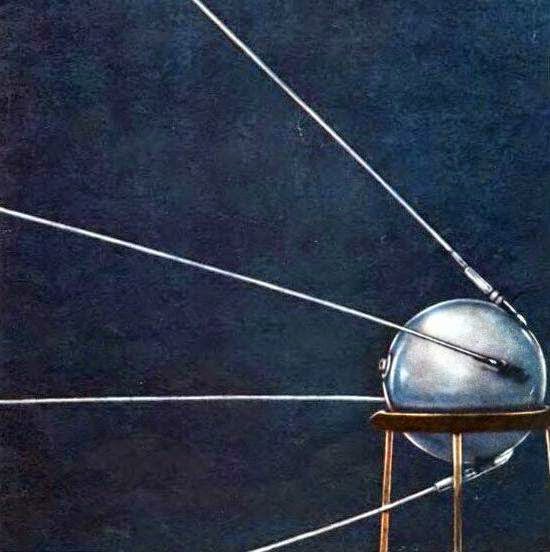
Over the past 5-10 years, space has become closer to non-specialists than ever before. The advent of SDR technology and then RTL-SDR dongles has opened an easy way into the world of radio for people who have never tried to do this.
')
Why is this necessary?
Curiosity. Although “everything can be found on the Internet,” few people think that from the beginning this “everything” is put on the Internet by someone. Someone writes stories, someone makes interesting photos, and then it diverges on the network by retweets and reposts.
You can still listen to the talks of astronauts who are particularly active at the time of the crew arrival / departure with the ISS. Some managed to catch negotiations during a spacewalk. Not everything shows NASA TV, especially because for Russia, for NASA, these are blind flight zones, and TDRS are still not flying in sufficient numbers. Out of curiosity, one can take weather satellites NOAA ( an example of a technique ) and Meteor (pictures have a better resolution example ) and find out a bit more information than it is published in the media.

You can learn first-hand how many cubesat are doing.
Some have programs for receiving and decoding telemetry, others are telegraphing explicitly. Examples can be found here .
It is possible to observe the operation of launch vehicles and accelerating units when a load is brought into a given orbit. The same equipment can be used to track stratospheric probes. Here , for example, is an amazing case for me - the ball flew out of Britain on July 12 and at an altitude of 12 kilometers already made a couple of world tours, flew to the North Pole. Recently seen over Siberia. Very few receiving stations involved in the project.
1. Receiver operating in the required range. In most cases, RTL-SDR meets sufficient requirements. Recommended preamp, notch filter. It is recommended to use a USB extension cable with ferrite filters - this will reduce the noise from the computer and will allow to place the receiver closer to the antenna. A good result gives the shielding of the receiver .
2. Antenna on selected range. "The best amplifier is the antenna." Whatever preamp would not be installed after the antenna, but if the antenna is bad, only noise will amplify, but not a useful signal.
3. In the case of receiving a satellite signal, you need to know what is flying, where and when. For this, satellite tracking programs are needed that indicate and predict the position of the satellite at a certain moment.
4. Programs for receiving and decoding telemetry cubesat or meteorological satellites.
The feature of satellite reception is the distance and Doppler effect.
According to reception theory, this document is well written from page 49 -
Satellite station for low earth orbit communication .
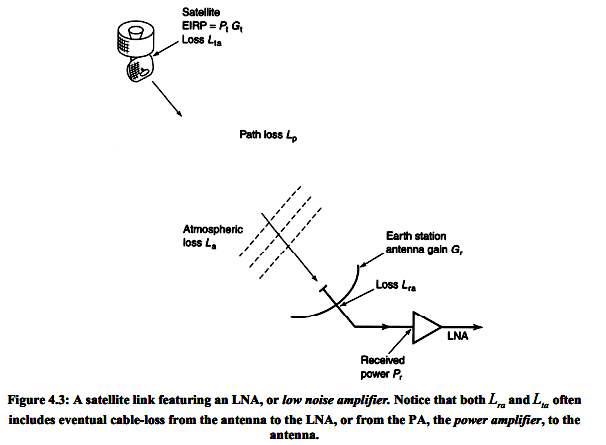
The derived formula [Eq. 4.10] shows that the power received by the receiver depends on the characteristics of the radiating and receiving antennas and is inversely proportional to the square of the distance between the receiver and the transmitter at the same wavelength. The longer the wavelength, the less radiation is scattered (“Why is the sky blue?”).
A satellite flying above its head is at a distance of several hundred kilometers, and a flight passing on your horizon may be at a distance of a couple of thousand kilometers. What is natural will decrease the level of the received signal by orders of magnitude.
And the transmitter power is not great, the chances of successful reception are not great. For example, in FunCube-1, the transmitter power on the illuminated side is 300 mW, and in the shade it is only 30 mW.
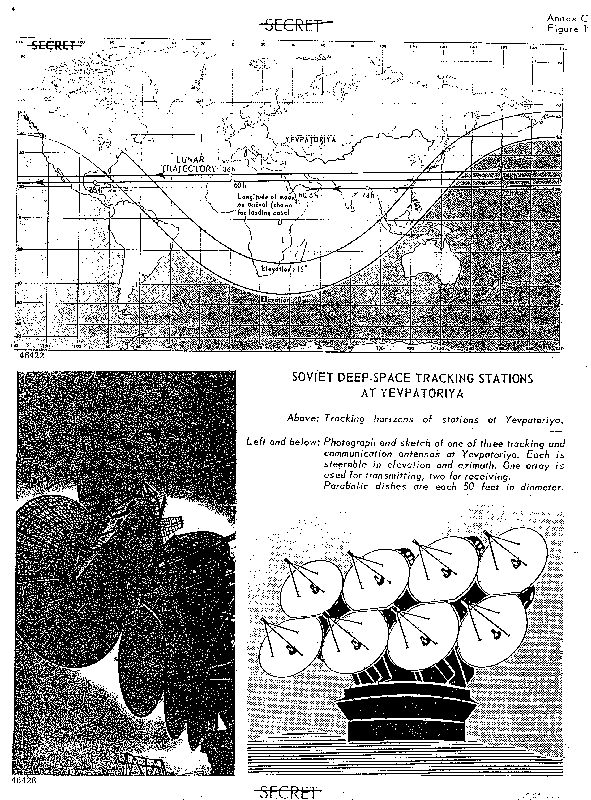
First of all, it depends on the place of reception and objects of reception. If it is a satellite with a polar orbit, then sooner or later it will fly over the receiving station. These are weather satellites, many cubesat. If this is, for example, the ISS, and the receiving station is in Moscow, then the ISS will fly only on the horizon. And in order to communicate or to hear a satellite for a long time, it is necessary to have highly efficient antennas. Therefore, it is necessary to decide - what is available is flying within reach of the reception site.
Online tools:
- www.satview.org
- www.n2yo.com
From programs for Windows: classic Orbitron ( program review ) and, for example, Gpredict .
The latter shows information on satellite frequencies. There are programs for other platforms, for example, for Android.
We will use Orbitron and frequency information from third-party sources.
Fortunately, the necessary data to calculate the orbits ( TLE set of orbital elements for the Earth satellite ) is freely distributed on the Internet and is available here . You do not even need to think about it - the programs automatically download the latest data on the orbits of space objects.
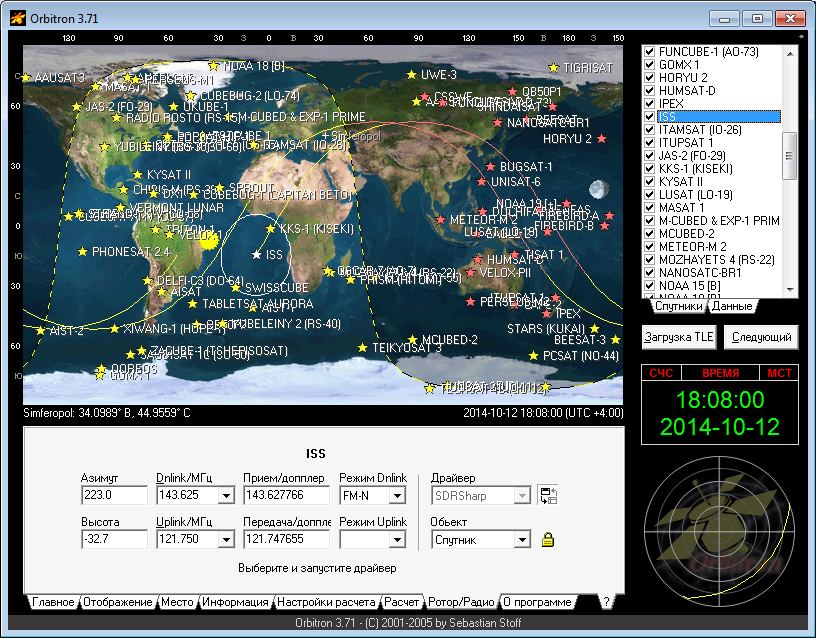
So, we can see satellites from an open base in the Orbitron program window, they are divided into geostationary, amateur, weather, ISS, etc. categories. Not all of them are of interest for the reception, some do not work and are of interest only for photographers of the night sky.
The frequencies of working satellites can be found here:
As can be seen from the table, these satellites mostly work in the 2 meter and 70 centimeters ranges.
And here is their set of orbital elements (TLE), the same instruction on how to set up automatic updating of these TLE in Orbitron.
In some cases, an omnidirectional antenna is needed, in others, a directional antenna, and in others, it is more convenient to use a dual-band antenna. Narrowly focused, require manual reference for an arbitrary satellite, or a positioner.
Let's see what "professionals use" . Photographs of antennas that Sven uses and used to observe Soviet satellites and spacecraft.
Spiral antenna 922 MHz - for receiving signals from the Progress, Soyuz TMA ships, and at 1020 MHz - Briz-M booster blocks. The antenna is fixed in one direction to the south because in Sweden, ships are visible low above the horizon and there is no need to turn it. Above - discone antenna 100-480 MHz - a universal application. Horizontal pattern. But when you receive meteorological, polar satellites flying at the zenith, there will be problems. Therefore, for such cases it is better to use a quadrifilar antenna for the required range.
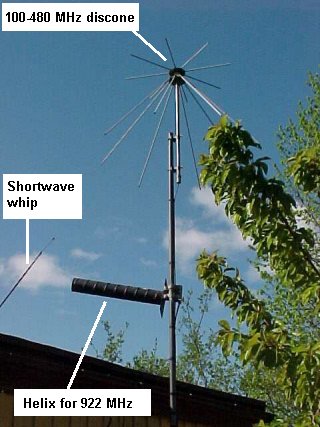
Antenna "wave channel" - the former television antennas are also directed and fixed in one direction.

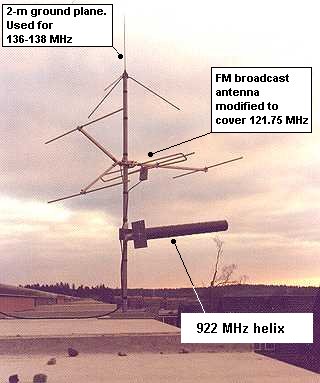
Antenna "wave channel" 920 MHz was intended for mobile phones. Sven Gran himself.
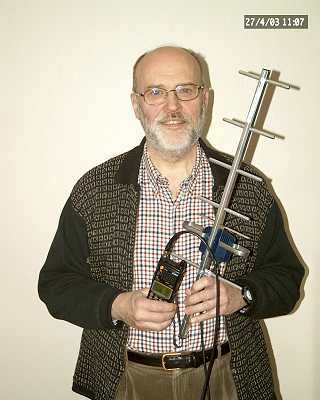
If there is no suitable factory / television antenna, then something simple can be made.
Simple dual-band (70 cm and 2 m) antenna:
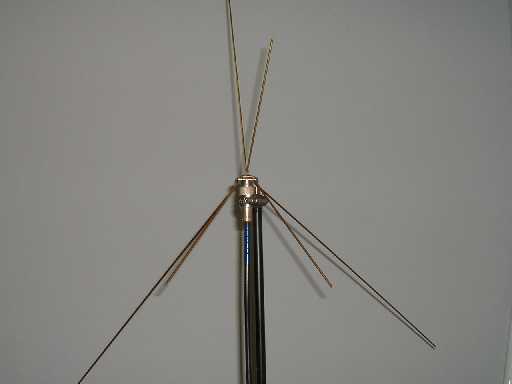
The simplest version of a quadrifilar antenna for weather satellites.
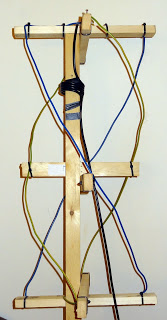
More capital option:
Instructions for the manufacture of a 137 MHz antenna for receiving signals from weather satellites. Quadrifilar Helix .

Whatever the antenna was the general condition - away from obstacles and higher from the ground. The more open the horizon, the more the session will last. And do not forget that in the case of a directional antenna, it must be “directed” towards the satellite.
So, you have an antenna of the required range, it is installed in an open space and connected to the tuner. Ideally with a preamp. Whenever possible, it is better to use a 2 meter USB extension cable than 2 meters of cable to the antenna.
It is recommended to calibrate the RTL-SDR , frequency deviations can be significant.
Launch your favorite program to work with RTL-SDR. On the screen below is the SDRSharp with FUNCube Dongle Pro.
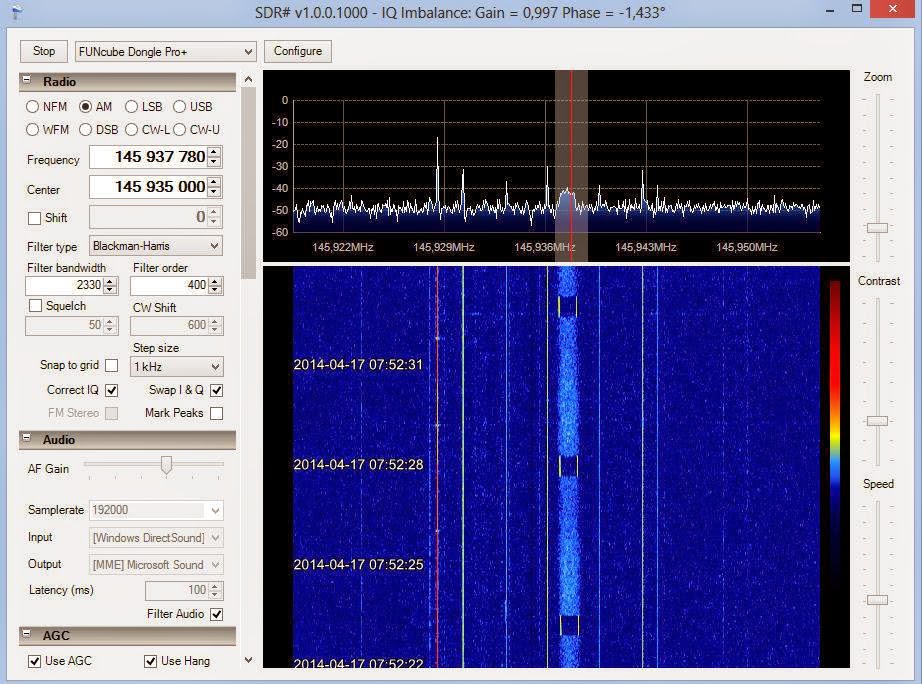
Cubesat FunCube-1 is being received on a quadrifilar antenna as the satellite passes at the zenith at the turn that is most beneficial for receiving .
 .
.
The signal is not very good, low-noise amplifier is needed. The spectrogram shows that the BPSK signal is interrupted by a tone every 5 seconds.
If you managed to receive a signal, you can proceed to the next stage - decoding the signal. In the case of FUNCube, you need to download the program Funcube telemetry dashboard.
Following the instructions set up the program:

And we accept telemetry:
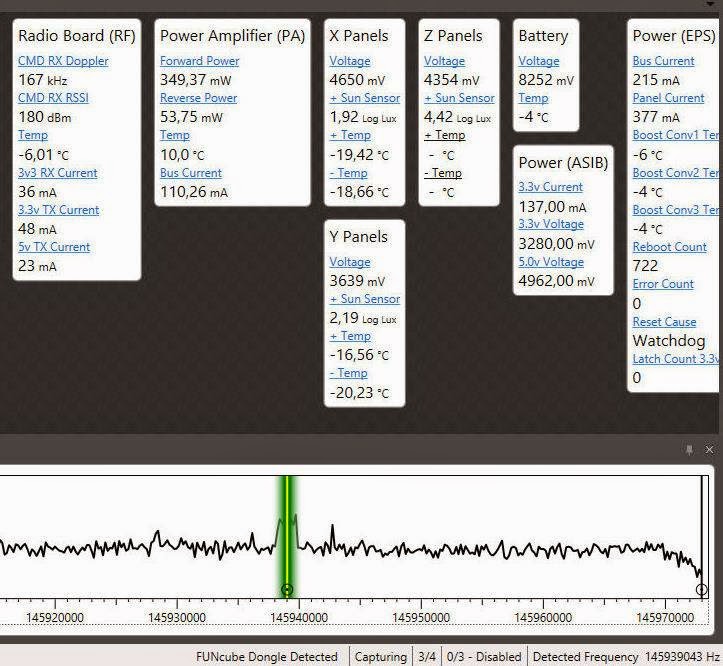
When receiving a satellite signal inevitably such a phenomenon as the Doppler effect. On the spectrogram, it will look like this :
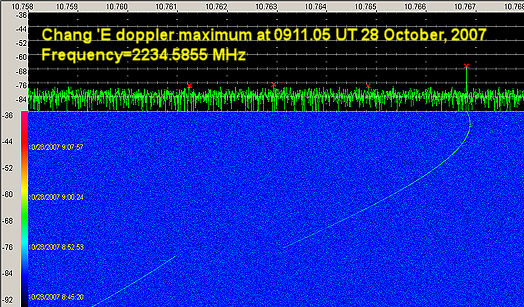
As the satellite approaches the receiving point, the frequency increases and decreases with distance. Such “drawings” on the spectrogram allow you to accurately determine that the signal belongs to the moving satellite, and not to the ground-based interference source. When receiving telemetry, you must manually adjust the frequency of the signal. It is possible to automatically adjust the frequency and again the Orbitron program will help with this, calculating the required frequency and controlling the SDRSharp or HDSDR program.
Configure SDRSharp and Orbitron .
Setting up HDSDR is much easier. In Orbitron we install the MyDDE driver in the same way as the article:
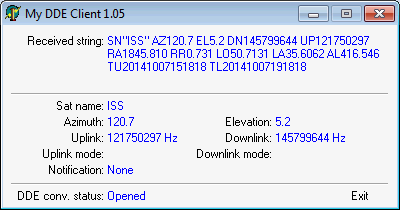
In HDSDR - Options \ DDE client.
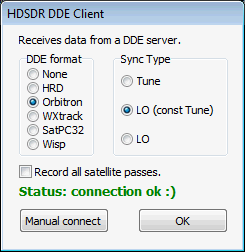
Before use, synchronize the clock over the Internet (with the nearest NTP server). Have a good hunting.
These weeks you can watch traditional events dedicated to the launch of the first Satellite - the beginning of the Space Age. The strength of the case satellite, which should be the first, became the third. And the first to fly a completely different device.
This text is about how easy it is to hear satellites in near-earth orbits and how it was at the beginning of the space age. Paraphrasing a once famous book by E. Iceberg: “Satellite is very easy!”

Over the past 5-10 years, space has become closer to non-specialists than ever before. The advent of SDR technology and then RTL-SDR dongles has opened an easy way into the world of radio for people who have never tried to do this.
')
Why is this necessary?
Remark about amateurs and the first satellites
If Sputnik was a big surprise for the West, then at least Soviet radio amateurs were warned a few months before the event.
Looking at the pages of the magazine "Radio" , you can find articles in the summer of 1957, both about an artificial satellite, the launch of which is expected in the near future, and the equipment circuit for receiving satellite signals.
The excitement caused by Sputnik was unexpected, and had a strong influence on such "non-scientific" areas of society, such as fashion, car design, etc.
The Kettering Group of amateur satellites trackers became famous in 1966 after discovering the Soviet space center in Plesetsk. A group of observers appeared in the gymnasium of the city of Kettering (Great Britain), and the original teacher using satellite signals from the satellites demonstrated the Doppler effect in physics lessons. In subsequent years, the group brought together amateurs, specialists from different countries. One of its active participants is Sven Gran, who has worked all his life in the Swedish space industry (Swedish Space Corporation).
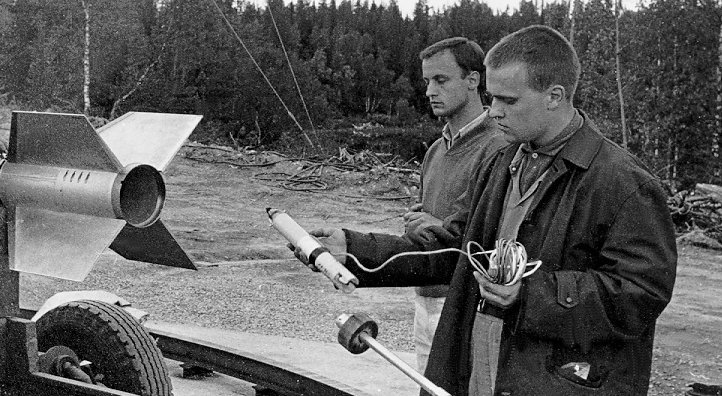
On his website he published articles on the history of early cosmonautics, audio recordings made in the 1960-1980s. It is interesting to listen to the voices of Soviet cosmonauts during everyday communication sessions. The site is recommended to explore the history of space enthusiasts.
Looking at the pages of the magazine "Radio" , you can find articles in the summer of 1957, both about an artificial satellite, the launch of which is expected in the near future, and the equipment circuit for receiving satellite signals.
The excitement caused by Sputnik was unexpected, and had a strong influence on such "non-scientific" areas of society, such as fashion, car design, etc.
The Kettering Group of amateur satellites trackers became famous in 1966 after discovering the Soviet space center in Plesetsk. A group of observers appeared in the gymnasium of the city of Kettering (Great Britain), and the original teacher using satellite signals from the satellites demonstrated the Doppler effect in physics lessons. In subsequent years, the group brought together amateurs, specialists from different countries. One of its active participants is Sven Gran, who has worked all his life in the Swedish space industry (Swedish Space Corporation).

On his website he published articles on the history of early cosmonautics, audio recordings made in the 1960-1980s. It is interesting to listen to the voices of Soviet cosmonauts during everyday communication sessions. The site is recommended to explore the history of space enthusiasts.
Curiosity. Although “everything can be found on the Internet,” few people think that from the beginning this “everything” is put on the Internet by someone. Someone writes stories, someone makes interesting photos, and then it diverges on the network by retweets and reposts.
You can still listen to the talks of astronauts who are particularly active at the time of the crew arrival / departure with the ISS. Some managed to catch negotiations during a spacewalk. Not everything shows NASA TV, especially because for Russia, for NASA, these are blind flight zones, and TDRS are still not flying in sufficient numbers. Out of curiosity, one can take weather satellites NOAA ( an example of a technique ) and Meteor (pictures have a better resolution example ) and find out a bit more information than it is published in the media.

You can learn first-hand how many cubesat are doing.
Some have programs for receiving and decoding telemetry, others are telegraphing explicitly. Examples can be found here .
It is possible to observe the operation of launch vehicles and accelerating units when a load is brought into a given orbit. The same equipment can be used to track stratospheric probes. Here , for example, is an amazing case for me - the ball flew out of Britain on July 12 and at an altitude of 12 kilometers already made a couple of world tours, flew to the North Pole. Recently seen over Siberia. Very few receiving stations involved in the project.
Actually, what is needed for reception?
1. Receiver operating in the required range. In most cases, RTL-SDR meets sufficient requirements. Recommended preamp, notch filter. It is recommended to use a USB extension cable with ferrite filters - this will reduce the noise from the computer and will allow to place the receiver closer to the antenna. A good result gives the shielding of the receiver .
2. Antenna on selected range. "The best amplifier is the antenna." Whatever preamp would not be installed after the antenna, but if the antenna is bad, only noise will amplify, but not a useful signal.
3. In the case of receiving a satellite signal, you need to know what is flying, where and when. For this, satellite tracking programs are needed that indicate and predict the position of the satellite at a certain moment.
4. Programs for receiving and decoding telemetry cubesat or meteorological satellites.
The feature of satellite reception is the distance and Doppler effect.
According to reception theory, this document is well written from page 49 -
Satellite station for low earth orbit communication .

The derived formula [Eq. 4.10] shows that the power received by the receiver depends on the characteristics of the radiating and receiving antennas and is inversely proportional to the square of the distance between the receiver and the transmitter at the same wavelength. The longer the wavelength, the less radiation is scattered (“Why is the sky blue?”).
A satellite flying above its head is at a distance of several hundred kilometers, and a flight passing on your horizon may be at a distance of a couple of thousand kilometers. What is natural will decrease the level of the received signal by orders of magnitude.
And the transmitter power is not great, the chances of successful reception are not great. For example, in FunCube-1, the transmitter power on the illuminated side is 300 mW, and in the shade it is only 30 mW.

What kind of antenna is needed, and for what range?
First of all, it depends on the place of reception and objects of reception. If it is a satellite with a polar orbit, then sooner or later it will fly over the receiving station. These are weather satellites, many cubesat. If this is, for example, the ISS, and the receiving station is in Moscow, then the ISS will fly only on the horizon. And in order to communicate or to hear a satellite for a long time, it is necessary to have highly efficient antennas. Therefore, it is necessary to decide - what is available is flying within reach of the reception site.
What programs exist for tracking satellites that indicate and predict the position of the satellite at a certain point?
Online tools:
- www.satview.org
- www.n2yo.com
From programs for Windows: classic Orbitron ( program review ) and, for example, Gpredict .
The latter shows information on satellite frequencies. There are programs for other platforms, for example, for Android.
We will use Orbitron and frequency information from third-party sources.
How do programs calculate satellite orbits?
Fortunately, the necessary data to calculate the orbits ( TLE set of orbital elements for the Earth satellite ) is freely distributed on the Internet and is available here . You do not even need to think about it - the programs automatically download the latest data on the orbits of space objects.
But it was not always so
The North American Aerospace Defense Command (NORAD) maintains a catalog of space objects and, in fact, the catalog is not fully public - there are no US military satellites in it. Groups of amateur enthusiasts are engaged in catching such objects. Sometimes they manage to find an object missing from an open database.
The question of determining and predicting the orbit arose before the launch of satellites. In the USSR, a wide range of observers and instruments were involved in solving this problem. In observation and measurement of the satellite orbit, in addition to the standard stations of trajectory measurements, the observatories and departments of higher educational institutions were involved, and the chosen easily accessible amateur radio band allowed the radio amateurs to be involved in the observations of the first satellites - in the 1957 Radio, you can find a radio direction finding system, a tape recording which the radio fan needed to be sent to the address of the USSR Academy of Sciences. At the first stage, the Krug system direction finders , belonging to a completely different department, were involved in unusual work.

Soon the ballistics of NII-4 achieved great success. For the first time, the computer program “Strela-2” developed by them allowed the orbit parameters to be determined not by information from direction finders, but by the results of trajectory measurements obtained by Binokl-D stations on NPCs. Now you can predict the movement of satellites in orbit.
Stations of trajectory measurements of the first generation "Irtysh" were gradually replaced by new stations "Kama" and "Wisla" with significantly higher technical indicators in range, accuracy and reliability. In the 1980s, laser rangefinders appeared. You can read more here .
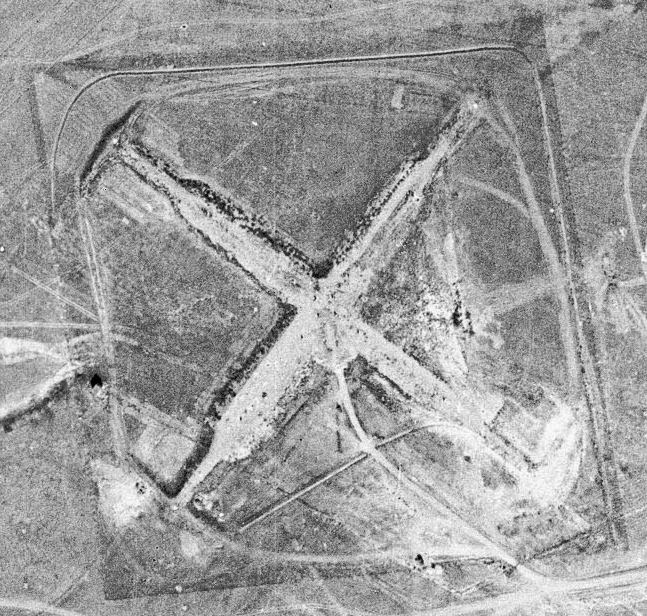
The stations measured the orbits of not only “their own”, but also the satellites of their beloved potential enemy. Optical and then radio reconnaissance satellites appeared very quickly in orbit. The fact that they could see back in 1965 will be lower. In the meantime, remember the anecdotal story of the soldiers of the far north, probably the only entertainment, which was the observance of the rules of radio and "optical" masking at the time of passage of the respective satellites. Once before the flight of an American optical reconnaissance satellite, they, naturally for fun, used slag from the boiler room to write a huge word on the snow.
But what about lovers hunt for satellites? They had to listen to the air, to peer into the sky after receiving news about the launch of the rocket from the spaceport. Usually, several turns after launch were predictable.

On a photo of 2000 maps containing sets of orbital elements for Earth satellites obtained by Sven Gran from NASA in the period 1977-1990. Then they could be obtained via dial-up access and then, in a few years, on the Internet. Sven scanned these maps for the theme group on Facebook. they contain sets of elements that are missing from the Spacetrack.org database.
These data were used to predict the turns on which observation of space objects is possible.
Naturally, no computers - only these two stencils were used 25 years ago. And by the time TLE was received, the data was not fresh.
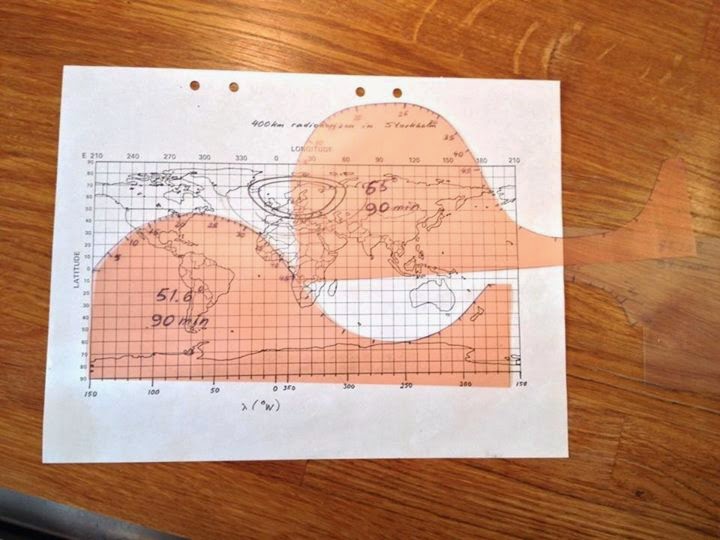
Later, to calculate the orbits, Sven used his own hand-written programs for the PC.
During the flight of the Satellite, the CIC did not yet have its own computer center, and the allocated computer time on computers of other organizations was not enough for all calculations, and the satellite’s orbit was accurately predicted by specially made stencils.
The question of determining and predicting the orbit arose before the launch of satellites. In the USSR, a wide range of observers and instruments were involved in solving this problem. In observation and measurement of the satellite orbit, in addition to the standard stations of trajectory measurements, the observatories and departments of higher educational institutions were involved, and the chosen easily accessible amateur radio band allowed the radio amateurs to be involved in the observations of the first satellites - in the 1957 Radio, you can find a radio direction finding system, a tape recording which the radio fan needed to be sent to the address of the USSR Academy of Sciences. At the first stage, the Krug system direction finders , belonging to a completely different department, were involved in unusual work.

Soon the ballistics of NII-4 achieved great success. For the first time, the computer program “Strela-2” developed by them allowed the orbit parameters to be determined not by information from direction finders, but by the results of trajectory measurements obtained by Binokl-D stations on NPCs. Now you can predict the movement of satellites in orbit.
Stations of trajectory measurements of the first generation "Irtysh" were gradually replaced by new stations "Kama" and "Wisla" with significantly higher technical indicators in range, accuracy and reliability. In the 1980s, laser rangefinders appeared. You can read more here .

The stations measured the orbits of not only “their own”, but also the satellites of their beloved potential enemy. Optical and then radio reconnaissance satellites appeared very quickly in orbit. The fact that they could see back in 1965 will be lower. In the meantime, remember the anecdotal story of the soldiers of the far north, probably the only entertainment, which was the observance of the rules of radio and "optical" masking at the time of passage of the respective satellites. Once before the flight of an American optical reconnaissance satellite, they, naturally for fun, used slag from the boiler room to write a huge word on the snow.
if you are 18+
But what about lovers hunt for satellites? They had to listen to the air, to peer into the sky after receiving news about the launch of the rocket from the spaceport. Usually, several turns after launch were predictable.

On a photo of 2000 maps containing sets of orbital elements for Earth satellites obtained by Sven Gran from NASA in the period 1977-1990. Then they could be obtained via dial-up access and then, in a few years, on the Internet. Sven scanned these maps for the theme group on Facebook. they contain sets of elements that are missing from the Spacetrack.org database.
These data were used to predict the turns on which observation of space objects is possible.
Naturally, no computers - only these two stencils were used 25 years ago. And by the time TLE was received, the data was not fresh.

Later, to calculate the orbits, Sven used his own hand-written programs for the PC.
During the flight of the Satellite, the CIC did not yet have its own computer center, and the allocated computer time on computers of other organizations was not enough for all calculations, and the satellite’s orbit was accurately predicted by specially made stencils.

So, we can see satellites from an open base in the Orbitron program window, they are divided into geostationary, amateur, weather, ISS, etc. categories. Not all of them are of interest for the reception, some do not work and are of interest only for photographers of the night sky.
The frequencies of working satellites can be found here:
As can be seen from the table, these satellites mostly work in the 2 meter and 70 centimeters ranges.
And here is their set of orbital elements (TLE), the same instruction on how to set up automatic updating of these TLE in Orbitron.
In some cases, an omnidirectional antenna is needed, in others, a directional antenna, and in others, it is more convenient to use a dual-band antenna. Narrowly focused, require manual reference for an arbitrary satellite, or a positioner.
Let's see what "professionals use" . Photographs of antennas that Sven uses and used to observe Soviet satellites and spacecraft.
Spiral antenna 922 MHz - for receiving signals from the Progress, Soyuz TMA ships, and at 1020 MHz - Briz-M booster blocks. The antenna is fixed in one direction to the south because in Sweden, ships are visible low above the horizon and there is no need to turn it. Above - discone antenna 100-480 MHz - a universal application. Horizontal pattern. But when you receive meteorological, polar satellites flying at the zenith, there will be problems. Therefore, for such cases it is better to use a quadrifilar antenna for the required range.

Antenna "wave channel" - the former television antennas are also directed and fixed in one direction.


Antenna "wave channel" 920 MHz was intended for mobile phones. Sven Gran himself.

If there is no suitable factory / television antenna, then something simple can be made.
Simple dual-band (70 cm and 2 m) antenna:

The simplest version of a quadrifilar antenna for weather satellites.

More capital option:
Instructions for the manufacture of a 137 MHz antenna for receiving signals from weather satellites. Quadrifilar Helix .

Whatever the antenna was the general condition - away from obstacles and higher from the ground. The more open the horizon, the more the session will last. And do not forget that in the case of a directional antenna, it must be “directed” towards the satellite.
A very big remark about the Soviet antennas of remote space communications
The development of the R-7 family of missiles went faster than satellites, partly because they gave the go-ahead to the satellites when the R-7 had already entered the flight test stage. The earliest creation of the third and fourth stages allowed them to reach the second cosmic velocity and carry out a rocket flight to the planets, the Moon, fly around the Moon, return to Earth and hit the Moon. There was no time to design anything from scratch, ready-made devices and components were used. For example, the antenna installation of the Zarya station for communication with the first manned ships consisted of four spirals mounted on the base of the searchlight installation left after the war.
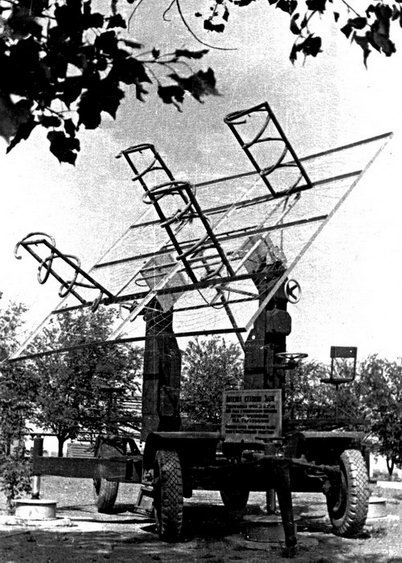
In the conditions of time trouble, for the long-range space communication those antennas were used that were already in the right place and with the necessary characteristics. More information about the time center of space communications can be found here .
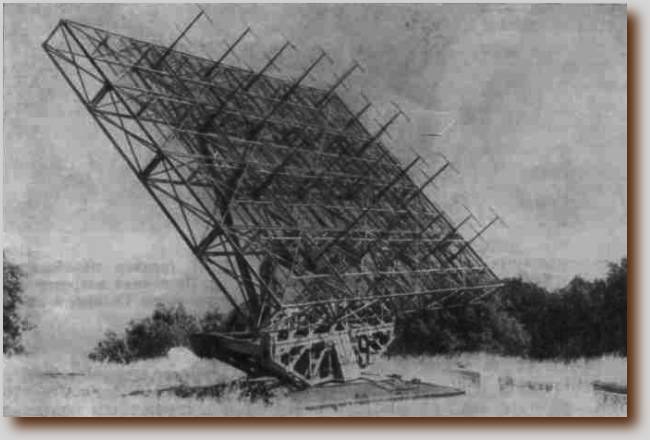
Simultaneously with the launches, two capital centers of distant space communications with the world's largest, at that time, space communications antennas were built “side by side” (by the way, the Far Space Communications Centers called them journalists, the real names were different - NPC-10 and NPC -16, but this, for some reason, is not quite correct names.).

The complex was also built from “ready-made units” and therefore was built in record time. The use of gun-boring devices as the base of the antennas caused the CIA a slight confusion, and for some time they believed that a coastal battery was being built. Two years later, there was a curiosity associated with the Soviet experiment on the "Pluto" complex to clarify the value of an astronomical unit by the radar of Venus. Probably, officials in the USSR decided that the significantly improved value of the astronomical unit is a state secret and distorted the published result of the experiment. The astronomers laughed at the awkward attempt to hide the meaning:
The antenna, which played a crucial role in the study of neighboring planets in the 1960-1970s, was cut into metal by Ukraine in November 2013.
Read more about NPC-16
To quote Boris Chertok:
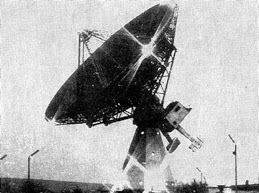
Read more about NPC-10 .
After another visit to the temporary communications center in Simeiz, Korolev and Keldysh were visited by fast-built communications centers on the way to the plane. In 1960, the Pluto radio-technical complex was put into operation at NPC-16, 7 months (!) After construction began, becoming the most powerful in the history of mankind at that time.
Two years later, at the NPC-10, a Katun remote space communications station was built with an antenna 25 meters in diameter, soon increased to 32.
Members of the State Commission G.A. Tyulin, S.P. Korolev (since 1966, G. N. Babakin), M.V. Keldysh emphasized the flight of the lunar and interplanetary vehicles. As a rule, after the launch of these satellites, they arrived at NIP-10 or NPC-16, heard reports from the management of LOCT or its groups, and in case of emergency situations, developers of onboard and ground-based technical means.
The likely adversary was actively interested in what was happening in the Soviet cosmonautics, thanks to which one can now find out a lot of interesting information from declassified reports and satellite photos. The topic of satellite espionage is very interesting and voluminous, anyone can read, for example, The US Deep Space Collection Program .
Here is an example of a fragment of a satellite photo and a fragment of the scheme from the CIA report on the largest Soviet center of space communications.
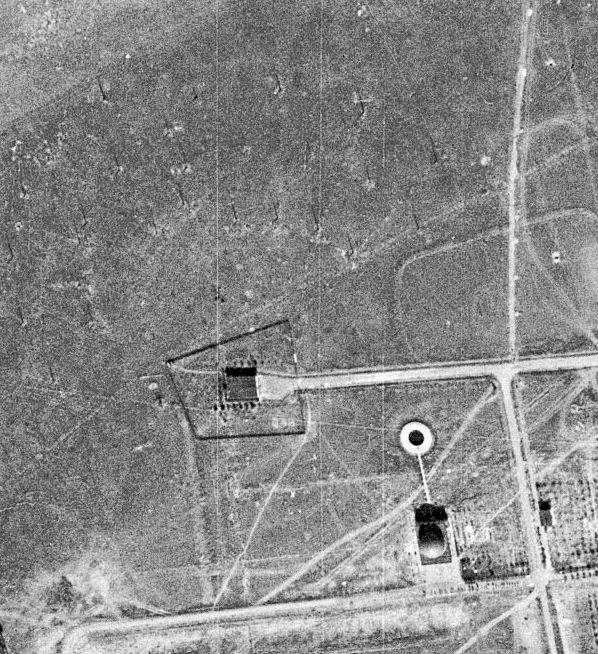
Without the report of the CIA, I would not have guessed that this is the antenna field of the HF communication center , which also performed the observation of the first Satellites.
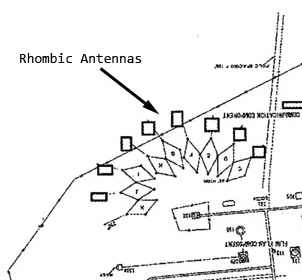
Awareness of the CIA in some issues is amazing, and it is clear that this is an analyst, and not intelligence information and a high class of engineers who correctly interpret the purpose of the structures in the photo.
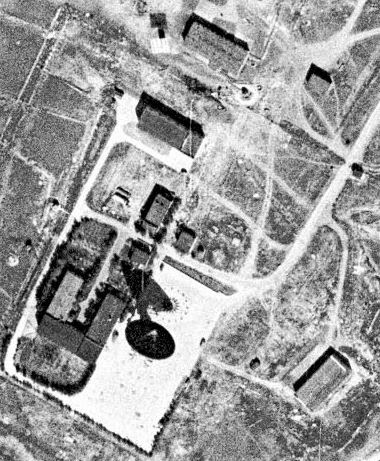
On the American photo platform of the station of remote space communication "Katun" with the buildings of control and antenna TNA-400.
The TNA-400 antenna leans towards the horizon and leads a communication session ... In the center of the upper border is a rectangle of an antenna in the form of an “antenna array” with common-mode spiral radiators, this is a 10 kW transmitter station for communication with lunar ships. She looked like this :

The shooting date is October 5, 1965. Judging by the shadows - time before noon. A day earlier, on the morning of October 4, Luna-7 was launched.
Let's listen to Boris Chertok :
, Google Earth, 9 , . , TIFF, - U- -651, , , « », , , . «» — .. , , - . Those. , . .
, - , . . 22 1975 — , -16 -400.
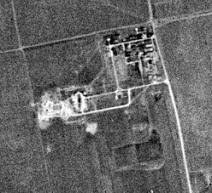
-2500 70 . 1982 KH-9 Hexagon .
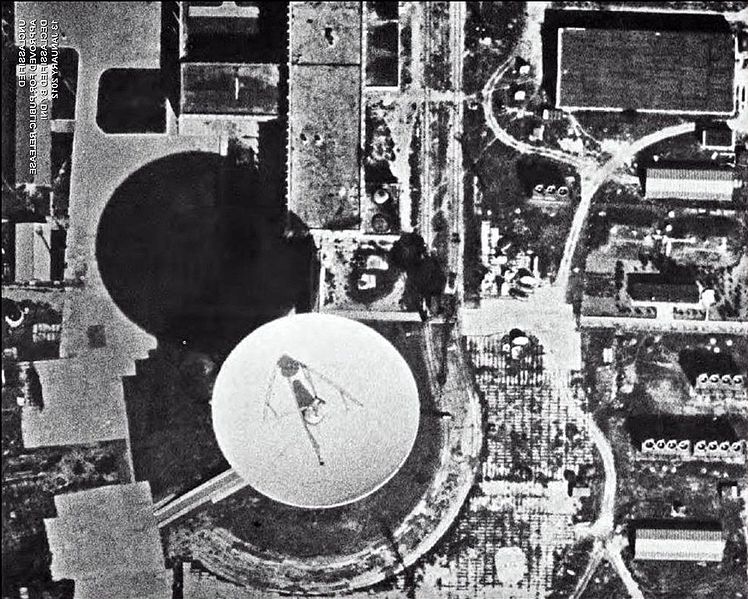
— , , . , , . — - , . .

In the conditions of time trouble, for the long-range space communication those antennas were used that were already in the right place and with the necessary characteristics. More information about the time center of space communications can be found here .

Simultaneously with the launches, two capital centers of distant space communications with the world's largest, at that time, space communications antennas were built “side by side” (by the way, the Far Space Communications Centers called them journalists, the real names were different - NPC-10 and NPC -16, but this, for some reason, is not quite correct names.).

The complex was also built from “ready-made units” and therefore was built in record time. The use of gun-boring devices as the base of the antennas caused the CIA a slight confusion, and for some time they believed that a coastal battery was being built. Two years later, there was a curiosity associated with the Soviet experiment on the "Pluto" complex to clarify the value of an astronomical unit by the radar of Venus. Probably, officials in the USSR decided that the significantly improved value of the astronomical unit is a state secret and distorted the published result of the experiment. The astronomers laughed at the awkward attempt to hide the meaning:
we should congratulate our colleagues on the planet. It surely wasn't Venus!
The antenna, which played a crucial role in the study of neighboring planets in the 1960-1970s, was cut into metal by Ukraine in November 2013.
Read more about NPC-16
To quote Boris Chertok:
Hidden text
According to preliminary calculations for reliable communication with spacecraft located inside the Solar System, a parabolic antenna with a diameter of about 100 meters must be built on Earth. The cycle of creating such unique structures was estimated by optimists at five to six years. And before the first launches on Mars, antennae had less than a year! By that time, a parabolic antenna of the Simferopol NPC-10 was being built. This 32-meter antenna was built for future lunar programs. It was hoped that its operation would begin in 1962.
The chief designer of SKB-567, Yevgeny Gubenko, accepted the bold proposal of engineer Efrem Korenberg: instead of one large paraboloid, combine eight sixteen-meter “cups” on a common turntable in a single design. The production of such medium parabolic antennas has already been well mastered. It was necessary to learn to synchronize and fold in the right phases of kilowatts emitted by each of the eight antennas during transmission. At the reception, thousands of watts of signals reaching the Earth from distances of hundreds of millions of kilometers had to be added.
The development of metalworking mechanisms and drives for turntables was another problem that could take several years. Not without a sense of humor, Agadzhanov explained that the Khrushchev’s ban on the construction of the newest heavy ships of the Navy rendered substantial assistance to the space program. The finished turntables of the turrets of the main caliber of the battleship under construction were quickly redirected, delivered to Evpatoria and installed on concrete foundations constructed for two antenna systems — receiving and transmitting.
Sixteen-meter parabolic antennas were manufactured by the Gorky Machine-Building Plant of the defense industry, the metal structure was assembled by the Heavy Machinery Research Institute, the drive technology was debugged by the Central Research Institute-173 defense technology, electronics, antenna guidance and control systems using ship-borne experience, developed by the Research Institute-1 shipbuilding industry, communication lines inside the NIP -16 and its exit to the outside world was provided by the Ministry of Communications, Krymenergo brought a power line, military builders paved the concrete roads, built offices, hotels and a military town with all services.
The scope of work was impressive. But the front was so wide that it was difficult to believe in the reality of the timelines that Agadzhanov called.
During conversations, Gennady Guskov drove up. He was Deputy Gubenko, here he supervised the entire radio engineering part, but of necessity he also interfered in construction problems.
- Both ADU-1000, receiving and transmitting, will be delivered on time! We will not fail, - he said cheerfully.
- Why a thousand? - asked Keldysh.
- Because the total effective area of the antenna system is a thousand square meters.
- No need to boast, - Ryazan intervened, - you will have a total area of not more than nine hundred!
It was a debate of supporters of different ideas, but at that time it was not up to a hundred square meters.
The chief designer of SKB-567, Yevgeny Gubenko, accepted the bold proposal of engineer Efrem Korenberg: instead of one large paraboloid, combine eight sixteen-meter “cups” on a common turntable in a single design. The production of such medium parabolic antennas has already been well mastered. It was necessary to learn to synchronize and fold in the right phases of kilowatts emitted by each of the eight antennas during transmission. At the reception, thousands of watts of signals reaching the Earth from distances of hundreds of millions of kilometers had to be added.
The development of metalworking mechanisms and drives for turntables was another problem that could take several years. Not without a sense of humor, Agadzhanov explained that the Khrushchev’s ban on the construction of the newest heavy ships of the Navy rendered substantial assistance to the space program. The finished turntables of the turrets of the main caliber of the battleship under construction were quickly redirected, delivered to Evpatoria and installed on concrete foundations constructed for two antenna systems — receiving and transmitting.
Sixteen-meter parabolic antennas were manufactured by the Gorky Machine-Building Plant of the defense industry, the metal structure was assembled by the Heavy Machinery Research Institute, the drive technology was debugged by the Central Research Institute-173 defense technology, electronics, antenna guidance and control systems using ship-borne experience, developed by the Research Institute-1 shipbuilding industry, communication lines inside the NIP -16 and its exit to the outside world was provided by the Ministry of Communications, Krymenergo brought a power line, military builders paved the concrete roads, built offices, hotels and a military town with all services.
The scope of work was impressive. But the front was so wide that it was difficult to believe in the reality of the timelines that Agadzhanov called.
During conversations, Gennady Guskov drove up. He was Deputy Gubenko, here he supervised the entire radio engineering part, but of necessity he also interfered in construction problems.
- Both ADU-1000, receiving and transmitting, will be delivered on time! We will not fail, - he said cheerfully.
- Why a thousand? - asked Keldysh.
- Because the total effective area of the antenna system is a thousand square meters.
- No need to boast, - Ryazan intervened, - you will have a total area of not more than nine hundred!
It was a debate of supporters of different ideas, but at that time it was not up to a hundred square meters.

Read more about NPC-10 .
After another visit to the temporary communications center in Simeiz, Korolev and Keldysh were visited by fast-built communications centers on the way to the plane. In 1960, the Pluto radio-technical complex was put into operation at NPC-16, 7 months (!) After construction began, becoming the most powerful in the history of mankind at that time.
Two years later, at the NPC-10, a Katun remote space communications station was built with an antenna 25 meters in diameter, soon increased to 32.
Members of the State Commission G.A. Tyulin, S.P. Korolev (since 1966, G. N. Babakin), M.V. Keldysh emphasized the flight of the lunar and interplanetary vehicles. As a rule, after the launch of these satellites, they arrived at NIP-10 or NPC-16, heard reports from the management of LOCT or its groups, and in case of emergency situations, developers of onboard and ground-based technical means.
The likely adversary was actively interested in what was happening in the Soviet cosmonautics, thanks to which one can now find out a lot of interesting information from declassified reports and satellite photos. The topic of satellite espionage is very interesting and voluminous, anyone can read, for example, The US Deep Space Collection Program .
Here is an example of a fragment of a satellite photo and a fragment of the scheme from the CIA report on the largest Soviet center of space communications.

Without the report of the CIA, I would not have guessed that this is the antenna field of the HF communication center , which also performed the observation of the first Satellites.

Awareness of the CIA in some issues is amazing, and it is clear that this is an analyst, and not intelligence information and a high class of engineers who correctly interpret the purpose of the structures in the photo.

On the American photo platform of the station of remote space communication "Katun" with the buildings of control and antenna TNA-400.
The TNA-400 antenna leans towards the horizon and leads a communication session ... In the center of the upper border is a rectangle of an antenna in the form of an “antenna array” with common-mode spiral radiators, this is a 10 kW transmitter station for communication with lunar ships. She looked like this :

The shooting date is October 5, 1965. Judging by the shadows - time before noon. A day earlier, on the morning of October 4, Luna-7 was launched.
Let's listen to Boris Chertok :
. , . «-7».
.
. . , , . -10, , . , , .
, Google Earth, 9 , . , TIFF, - U- -651, , , « », , , . «» — .. , , - . Those. , . .
, - , . . 22 1975 — , -16 -400.

-2500 70 . 1982 KH-9 Hexagon .

— , , . , , . — - , . .
So, you have an antenna of the required range, it is installed in an open space and connected to the tuner. Ideally with a preamp. Whenever possible, it is better to use a 2 meter USB extension cable than 2 meters of cable to the antenna.
It is recommended to calibrate the RTL-SDR , frequency deviations can be significant.
Launch your favorite program to work with RTL-SDR. On the screen below is the SDRSharp with FUNCube Dongle Pro.

Cubesat FunCube-1 is being received on a quadrifilar antenna as the satellite passes at the zenith at the turn that is most beneficial for receiving .

The signal is not very good, low-noise amplifier is needed. The spectrogram shows that the BPSK signal is interrupted by a tone every 5 seconds.
If you managed to receive a signal, you can proceed to the next stage - decoding the signal. In the case of FUNCube, you need to download the program Funcube telemetry dashboard.
Following the instructions set up the program:

And we accept telemetry:

How the telemetry of Soviet spacecraft was deciphered in the first space decade
.
***
According to the memoirs, the death of the Soyuz-11 is connected with this, the pressure drop in which was immediately recorded on recorder tapes, but there was no such talent around them to decipher on the fly, raise an alarm and warn the crew earlier than they themselves felt a fatal pressure drop . Unfortunately, the development of an automated telemetry reception and decryption system has not yet been completed.
8 1967 ., 300 , «-4» . Began the final communication session. According to the rate of increase in the frequency of the signal received from the OO, a rapid increase was felt — under the influence of the Venus field — the speed of encountering the planet. But the signal disappeared - the oncoming atmospheric flow disturbed the orientation of the station's parabolic antenna to the Earth. At the same time, onboard automation issued a command to the CA department. : . . Finally, a loud shout was heard over the speakerphone: “There is a signal from the SA!” After a few minutes, information began to come in: “Pressure 0.05 atm, temperature minus 33 ° C, CO2 content in the atmosphere about 90%” - and after a short pause: “Information from radio altimeter fails. "
, , – «», – , .
***
One of Sergey Leonidovich's assistants, slightly bent down to the indicator screen:
- There is a telemetry. Must go first switch.
- Mirochka in place? - asked Babakin.
- Of course. Now we ask what she sees.
... Mirochka. Or, if completely, - Revvmir Prjadchenko.
This name was invented by her parents, combining two words in it: “revolution” and “peace”. Was in years past such a fashion. In the group of managers of the World, he was an exceptional person who possessed the phenomenal ability to keep in mind dozens of operations that were to be carried out by the station’s instruments and systems using radio commands sent from the Earth or from onboard HLPs. Perhaps, like no one else, she knew how to understand and interpret telemetric signals, sometimes quite confused by radio disagreement.
By golly, this gift of hers could successfully compete with any automatic way of processing information. More than once, our managers puzzled their sophisticated colleagues, declaring that our information from VENER is processed by a special Mira-1 system.
- How is it - Mira-1? No such machines. The Mir-1 computer is, and the Mira-1 computer ...
- That's it and it is that you have "Peace", and we have "Peace"!
And what beautiful poems Mirochka wrote ...
Babakin took the microphone.
- Mirochka! Good day. Well, what have you got?
- Hello, Georgiy Nikolayevich! “She recognized the Chief by her voice.” - While I can not say anything. By telemetry continuous failures. Parameters cannot be selected.
- Well, at least something ...
- Now ... just a minute ... so far I can only say one thing, but I cannot guarantee ... now ... DPR is not normal ...
Chief lowered his hand with a microphone.
- DPR ... DPR ... Is this pressure after the gearbox?
At the table moved. At the same time, some confusion appeared with concern on the faces of managers.
The big one looked at the Chief, then at Azarkh. A technical manual exists to make decisions about what to do next in a difficult situation, whether to continue the session or issue a shutdown command?
The difficulty was that the program-temporary device worked on board the station, impartially issuing command-signals in the necessary sequence for orientation of the station and switching on the corrective engine. This device worked, and he was unaware that some kind of DPR was not normal ...
“What can it lead to ... what ... what for?” - Major thought for a second, - to increased gas consumption, to excessive friction on orientation nozzles, right? The station can not navigate?
“Georgy Nikolayevich, you need to figure it out,” one of the managers said without hiding excitement.
The chief took the microphone:
- Mirochka, so what?
And the neon digits of the stopwatch snapped off seconds and minutes, which have already become very short.
- I understand, failures are solid until I say anything new ...
- Shut down the station, hang up? - Big questioningly looked at the Chief.
- Set aside hang up. Do not worry. Let the session go.
The rough, shaggy hillock of the distant voice of the station was beating on the indicator. Why is it so, as if under the law of “dirty tricks”, precisely when the information was more necessary than ever, it could not be “extracted” from the turbidity of failures and interferences?
- Can we repeat? Is there enough gas in the orientation system? - Continued interrogation technical leader. - No, it is necessary to assemble a working group and carefully arrange everything on the shelves, in order ...
- Yes, what "shelves!" In extreme cases, the correction session will have to be repeated ...
- Is it real? Is gas enough? It takes a lot of thought. Georgiy Nikolaevich ...
The circular reproducer and Mirochka's joyful voice clicked, unusually filled with ringing notes and interrupted by excitement:
- Georgiy Nikolayevich! Deciphered! Everything is good! DPR - OK! Fine!
And immediately relieved tension. And on the clock - 11 hours 03 minutes. And just some 5 minutes passed. Just five minutes ...
According to the memoirs, the death of the Soyuz-11 is connected with this, the pressure drop in which was immediately recorded on recorder tapes, but there was no such talent around them to decipher on the fly, raise an alarm and warn the crew earlier than they themselves felt a fatal pressure drop . Unfortunately, the development of an automated telemetry reception and decryption system has not yet been completed.
When receiving a satellite signal inevitably such a phenomenon as the Doppler effect. On the spectrogram, it will look like this :

As the satellite approaches the receiving point, the frequency increases and decreases with distance. Such “drawings” on the spectrogram allow you to accurately determine that the signal belongs to the moving satellite, and not to the ground-based interference source. When receiving telemetry, you must manually adjust the frequency of the signal. It is possible to automatically adjust the frequency and again the Orbitron program will help with this, calculating the required frequency and controlling the SDRSharp or HDSDR program.
Configure SDRSharp and Orbitron .
Setting up HDSDR is much easier. In Orbitron we install the MyDDE driver in the same way as the article:

In HDSDR - Options \ DDE client.

Before use, synchronize the clock over the Internet (with the nearest NTP server). Have a good hunting.
Doppler effect 50 years ago
I will quote another memoir:
What is this frequency tuning system? You can imagine this system and its complexity and size, if it is known that it consisted of a variety of quartz resonators differing from each other in the frequency of ONE HERZ.
The console glows with colored lights — blue and green pulses run across the oscillographs.
- Tick-tick, tick-tack — like a metronome, a device clicks. Slowly time passes. Expectation. Concerned faces.
Tik-tik, tik-so. For a long, long time is the signal. After all, he will have to run 78 million kilometers. 4 minutes 20 seconds will go to this ... Yes! There is!
***
Physical Doppler effect comes to the rescue. As is known, the higher the speed of the device emitting radio signals, the stronger the frequency shift of this signal. The magnitude of the displacement can determine the speed and stability of flight.
It's seven in the morning. Outside the window it is dawning. The counters of the frequency tuning system, which constantly rearranges the parameters of the receiving antenna so that the signal changes due to an increase in speed, are beginning to occur, which means that the attraction of Venus is becoming more and more pronounced. The speed is increasing. Before the planet is only 15 thousand kilometers.
The buzzer almost chokes. Fast growing speed. Venus is getting closer and closer. At 7 o'clock 25 minutes, the last command of Earth left - to turn on the program-temporary device. The station is now completely independent.
What is this frequency tuning system? You can imagine this system and its complexity and size, if it is known that it consisted of a variety of quartz resonators differing from each other in the frequency of ONE HERZ.
Source: https://habr.com/ru/post/362147/
All Articles
